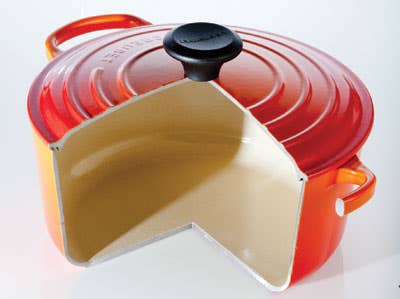
Pot of Gold: The Le Creuset Dutch Oven
As we developed recipes for this issue — from the deep-fried spicy Thai chicken wings to the slow-cooked Brazilian fish stew — we relied heavily, as always, on our Le Creuset cookware. Take the signature casserole, the French Oven: It heats up evenly, retains that heat, and transfers from stovetop to oven to table better than any pot we know. At the Le Creuset factory in northern France, they keep an example like the one pictured here on hand, with a portion cut away to reveal a cross-section of the materials employed in its design. Le Creuset's artisans have been making pots this way since 1925, pouring molten metal into black sand molds, which are destroyed after the casting process and recycled for future use. The cast iron is then covered with layers of vitreous enamel. Here's a closer look at how that engineering produces such consistently stellar results.
Exterior Enamel The colorful, thin layers of enamel on the outside give Le Creuset pots their iconic look, and this extra protective coating helps prevent cracking and increases durability. Two different colors are gradated so the top of the pot is a lighter shade than the bottom.
Cast Iron This metal makes a superior cooking base. It stands up to very high temperatures, retains heat extremely well, and conducts heat evenly in the oven. And it's tough—it can go straight from refrigerator to stove without expanding, contracting, or breaking.
Top Knob The sturdy knob affixed to the French Oven's lid is made from a composite phenolic material that can take the oven's heat—it is rated to withstand temperatures up to 500 degrees—and will stay cool to the touch even after hours of stove-top braising.
Interior Enamel The sand-colored interior coat of enamel keeps the cast iron from reacting with ingredients, so there's no metallic aftertaste to tomato-based sauces and other acidic foods. It also protects the cast iron from rust, making the pots long lasting and easy to clean.
Keep Reading
Continue to Next Story










